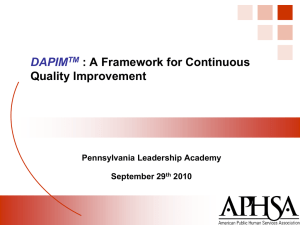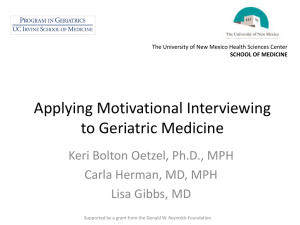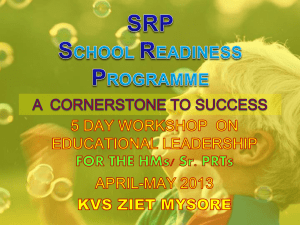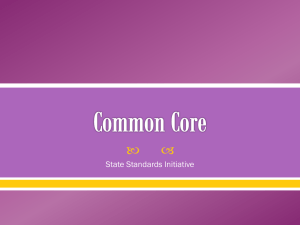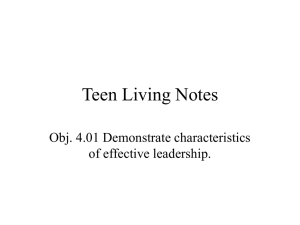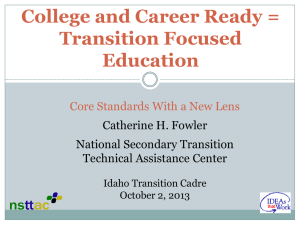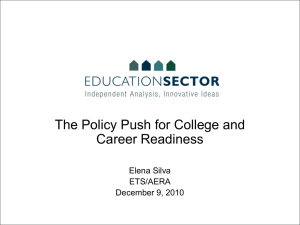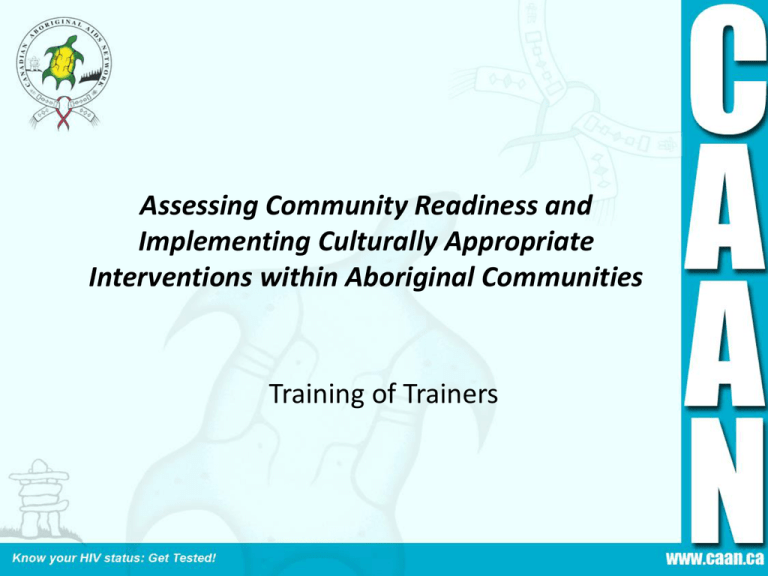
Assessing Community Readiness and
Implementing Culturally Appropriate
Interventions within Aboriginal Communities
Training of Trainers
Purpose
To provide Community Trainers with the knowledge and
skills to train community facilitators who in turn will be
able to:
• assess their community’s readiness to address risk reduction;
• determine culturally appropriate prevention and intervention
approaches;
• implement the approaches to effectively reduce risk and reduce
vulnerability for HIV infection; and,
• provide wise practices that demonstrate successful application of
the community readiness model for risk reduction and features
various case studies outlining lessons learned.
Agenda
Pre-Training Questionnaire
Module 1: The Issue: The Need for Culturally Appropriate Interventions in
Aboriginal communities
Module 2: Community Planning
Module 3: Community Readiness Model
Module 4: Conducting Your Community Readiness Assessment
Module 5: Moving From Assessment to Action Planning
Evaluating Your Risk Reduction Action Plan
Final Questions/Answers
Post-Training Questionnaire
Workshop Reflections and Closing
Additional Agenda
The training is one day
There are 6 Modules:
Module 1 – 4 are designed to inform them about the community
readiness model and how to conduct the assessment
Module 5 will give them knowledge and skills to engage the
community in a workshop – presenting their community readiness
results (including definition of readiness) and to develop their
strategies/action plan.
Additional Agenda
A Reflection process after the conclusion of each module – to provide
an opportunity for participants to share their thoughts about the process,
ask questions, or table any concerns.
Before Module 1:
complete a “confidential” Pre-Training Questionnaire.
After the completion of the Modules :
information on evaluation will be shared,
question period
Post-Training Questionnaire.
Module 1 (ex.1): The Issue
Aboriginal people are overrepresented in the HIV epidemic
in Canada.
1979 to Dec 2008: 21,300 AIDS cases reported:
16,824 (79%) included information on ethnicity.
690 were reported to be Aboriginal people.
Aboriginal people only make up 3.8% of the population.
Module 1 (ex.1): The Issue
In 2008, PHAC surveillance data demonstrated that:
Aboriginal people make up a growing % of HIV+ test reports and
reported AIDS cases;
Injecting drug use is a key mode of transmission especially for women
(Aboriginal female cases: 64.4% - 53.7% for Aboriginal male cases);
Aboriginal youth are diagnosed at a younger age than non-Aboriginal
youth.
Module 1 (ex.1): The Issue
Walk with Me Pathway To Health:
That the number of people with HCV in Canada is increasing at a
steady rate;
PHAC - major mode of contracting HCV is sharing of contaminated
needles /other needle works among injection drug users; and,
Estimates indicate more than 1500 HIV+ Aboriginal people are coinfected with HCV - presents other health management and outcome
complications.
Module 1 (ex.2): The Issue
Exercise
Explain - Risk Factors vs. Risky Behaviours
Brainstorm:
“What are some risk factors for infection, and risky
behaviours that people engage in that place them at high risk
for HIV and/or HCV infection?”
Module 1 (ex.3): The Issue
Exercise
Target populations with escalated risk?
Brainstorm:
“Which specific populations are experiencing
escalated rates of infection?”
“What is the issue that leads to higher risk?”
Module 1 (ex.4): The Issue
Exercise
Abstinence-based approaches are more common
in Aboriginal communities, but culturally
appropriate intervention approaches are also
needed to reduce the risk.
Brainstorm:
“Why are risk reduction intervention approaches
needed? To either compliment or replace
abstinence-based approaches?”
Module 2: Community
Planning
Where they
are
Where do
they want
to be
How do
they want
to get there
Module 2: Community Planning
“Walk with Me Pathway to Health”
Module 3: Community
Readiness Model
Definition:
Model for community change;
Integrates its culture, resources and level of readiness;
Brings community together, builds cooperation and increases its
capacity for prevention and intervention;
Recognizes community uniqueness different stages of willingness
and ability;
Readiness is “the degree to which a community is prepared to
take action on an issue”.
Risk reduction to prevent HIV /HCV infection.
Module 3: Community
Readiness Model
Risk
reduction
Module 3: Community
Readiness Model
Dimensions:
A. Community Efforts
B. Community Knowledge of the Efforts
C. Leadership
D. Community Climate
E. Community Knowledge about the Issue
F. Resources Related to the Issue
Module 3: Community
Readiness Model
Stages of Readiness
1.
2.
3.
4.
5.
6.
7.
8.
9.
No Awareness
Denial / Resistance
Vague Awareness
Preplanning
Preparation
Initiation
Stabilization
Confirmation/ Expansion
High Level of Community Ownership
Module 1 -2-3: Reflections
Experience:
What did you learn from the module(s)?
What did you need to know in order to prepare for community
readiness?
Identify:
How was the experience significant to you?
What do you understand better about yourself?
Your role?
Analyze:
What helped you to learn?
What do you feel about what you learned?
Generalize:
How will you apply what you learned to being a Facilitator of
Community Readiness?
Is there anything that you would change about the process?
Module 4: Conducting Your
Community Readiness Assessment
Three Steps to conducting interviews:
1. Prepare and plan;
2. Conduct; and,
3. Score.
To prepare:
Identify who you want to interview;
Have a thorough understanding of the questions;
and,
Contact interviewees and arrange interview.
Module 4: Conducting Your Community
Readiness Assessment
Exercise: Brainstorm and list key respondents …..
“ Who are some potential key respondents in your
community?” (Ask yourselves … are they connected to the
issue? Are any of them “gatekeepers” in the community –
respected, well connected people?)
Once listed
“Explain why these respondents are appropriate for this issue.”
Module 4: Conducting Your Community
Readiness Assessment
Read the Interview Questions and Discuss;
A – Community Efforts (Programs, Activities, Policies, etc.)
B – Community knowledge of efforts - In your community, how much of a
concern is providing services that reduce risk and risky behavior associated to
HIV and AIDS an HCV infection?
C – Leadership - For the “leaders” in your community, how much of a concern is
reducing risk?
D – Community Climate - Are there ever any circumstances in which members of
your community might think that denying services to individuals who are “under
the influence or who practice other risky behaviours should be tolerated? Please
explain.
E - Knowledge about the issue – How knowledgeable are community members
about risk reduction. Please explain. (such as: dynamics, signs symptoms,
statistics, effects on family and friends, etc.)
F – Resources for prevention efforts (time, money, people, space, etc.) On a
scale from 1-10, what is the level of expertise and training among those working
on providing services to reduce risk? With 1 being “very low” and 10 being “very
high”. Please explain.
Module 4: Conducting Your
Community Readiness Assessment
Practice Interviewing and Recording
1. Score the interviews
2. Using the Anchored Scoring sheet guide and
recording on the Assessment Scoring Sheet, create a
score for each of the six dimensions. Remember
interviews are scored by dimensions not by individual
questions.
Module 4: Conducting Your Community
Readiness Assessment
Scoring Process
Presentation, Exercise and Samples of Risk Reduction
Strategies
Module 5: Moving from Assessment to
Action Planning
“WORKSHOP tool CRM presentation”
Module 4: Reflections
Experience:
What did you learn from the module(s)?
What did you need to know in order to prepare for
community readiness?
Identify:
How was the experience significant to you?
What do you understand better about yourself? Your role?
Analyze:
What helped you to learn?
What do you feel about what you learned?
Generalize:
How will you apply what you learned to being a Facilitator of
Community Readiness?
Is there anything that you would change about the process?
Module 5: Moving from
Assessment to Action Planning
Exercise - “Brainstorming Intervention Strategies”
STRENGTHS
“What strengths does a community have that will help
reduce the risk of HIV and/or HCV infection?”
CONCERN
“What are the concerns or obstacles to implementing
strategies focused on reducing the risk?”
RESOURCES
“What are our resources that support strategies for reducing
the risk for HIV and HCV infection?”
Module 5: Moving from Assessment to
Action Planning
Module 5: Reflections
Experience:
What did you learn from the module(s)?
What did you need to know in order to prepare for community
readiness?
Identify:
How was the experience significant to you?
What do you understand better about yourself? Your role?
Analyze:
What helped you to learn?
What do you feel about what you learned?
Generalize:
How will you apply what you learned to being a Facilitator of
Community Readiness?
Is there anything that you would change about the process?
Evaluation
Logic Model
Illustrates how and why a program or strategy works
Shows, “…how all the program goals, activities, and
expected outcomes link together” (Shackman, 2010).
Goals
Goals describe future expected outcomes or states.
They provide programmatic direction - focusing on ends
rather than means.
For example, your goal may be to reduce the spread of HIV
and HCV in your community by delivering programs and
services that effectively reduce and/or change risky
behaviours.
Evaluation
Objectives
Objectives are clear, realistic, specific, measurable, and
time-limited, statements of action which when
completed will move towards goal achievement.
Objectives tell how to meet a goal.
For example, objectives may be:
To raise community awareness about risky
behaviours that may lead to HIV infection;
To reduce risk by promoting safer sex practices.
Evaluation
Inputs
What are the resources that will go into accomplishing your goal? Resources
can be funds, people, capital items, etc.
Activities
Activities include services, products, and more. They serve your goal and are
clearly linked to the objectives.
Example:
Objective
To raise community awareness about risky behaviours that may lead to HIV
infection..
Activities
Series of workshops
Information brochures about HIV and HCV.
Evaluation
Outcomes
Outcomes are the preferred consequences of
achieving the set out goals.
Short term outcomes
Intermediate outcomes
Long Term outcomes
Quantitative measures - measured in numbers.
Qualitative measure are descriptive, cannot me
counted.
Closing
CAAN
6520 Salish Drive
Vancouver, BC
V6N 2C7
Email: info@caan.ca
Internet: http://www.caan.ca
Ph: 604 266-7616
Fax: 604 266-7612
Toll free: 1 888 285 2226



